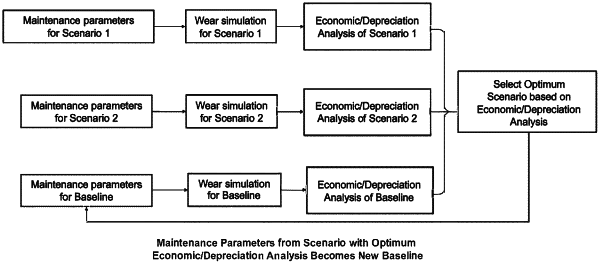| CPC G06F 30/20 (2020.01) [B61K 9/00 (2013.01); B61K 9/10 (2013.01); E01B 31/17 (2013.01); G06F 30/17 (2020.01); G06F 30/23 (2020.01); G06F 2119/14 (2020.01)] | 19 Claims |

|
1. A method for maintaining a train track, the method comprising:
modeling wear in a rail of the train track due to an estimated train traffic in order to provide maintenance recommendations for the train track by:
obtaining a train wheel profile of a train car;
providing two or more sets of maintenance parameters, each set of maintenance parameters including:
a rail profile;
grinding parameters; and
rail material properties;
wherein at least one pair of corresponding maintenance parameters in the two or more sets of maintenance parameters is different from one another;
for each of the at least two sets of maintenance parameters:
generating a contact model of an interaction between the rail profile and a wheel of a train based on the rail profile, the train wheel profile, and the estimated train traffic on the rail;
generating a wear model based on the rail material properties;
performing a wear simulation using the rail profile for a predetermined time period by:
running the contact model to produce a simulated loading on the rail, wherein the simulated loading represents a passage of the wheel of the train;
running the wear model to produce a simulated wear profile based on the simulated loading; and
generating an updated rail profile by modifying the rail profile by the simulated wear profile and a grinding profile, wherein modifying the rail profile by the grinding profile includes reducing rail material of the rail profile;
repeating the wear simulation iteratively by using, in each subsequent wear simulation, the updated rail profile generated during the previous wear simulation until a final updated rail profile exceeds a predetermined wear limit for the rail, wherein the predetermined time period of the wear simulation is one month or less, and wherein the predetermined wear limit includes a wear fail limit; and
calculating a wear time until the final rail profile exceeds the predetermined wear limit, wherein the wear time is at least one year;
comparing a cost value for each set of maintenance parameters, wherein the cost value is based on
maintenance costs associated with the corresponding set of maintenance parameters, and
an annual depreciation cost associated with the corresponding set of maintenance parameters, wherein calculating the annual depreciation cost is inversely proportional to the wear time; and
replacing at least a portion of the rail of the train track prior to the wear time elapsing.
|